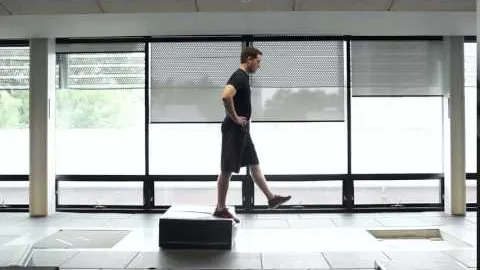

The drop jump exercise is a highly effective plyometric training technique that has gained popularity among athletes and fitness enthusiasts. This exercise involves dropping down from an elevated surface and immediately exploding into a jump upon landing. It is an excellent way to improve lower body power, strength, and overall athletic performance.
Power Development: Drop jumps are known for their ability to develop explosive power, which is crucial for sports such as basketball, soccer, and track and field. This exercise targets the fast-twitch muscle fibers, responsible for generating maximum force in a short amount of time.
Vertical Jump Height: By regularly incorporating drop jump exercises into your training routine, you can significantly enhance your vertical jump. This improvement translates to better performance in sports like basketball, volleyball, and gymnastics, where height is a key factor.
Lower Body Strength: Drop jumps engage the muscles in the lower body, including the quadriceps, glutes, and calves. As these muscles repeatedly absorb force upon landing and quickly generate power for the jump, they become stronger and more resilient.
Injury Prevention: Since drop jumps require proper landing techniques and controlled eccentric muscle contractions, they can improve both strength and stability in the lower body. This can help prevent common injuries, such as ACL tears and ankle sprains.
To perform a drop jump, follow these steps:
Find an Elevated Surface: Choose a box or step that is around knee height. Ensure that it is stable and able to support your body weight.
Start with a Soft Bend: Stand on the edge of the box or step with your feet hip-width apart. Begin by softening your knees before dropping down.
Focus on Good Landing Technique: As you drop down, keep your core engaged and your chest up. Land with a slight bend in your knees, ensuring that your knees are tracking over your toes. Avoid excessive flexion or valgus collapse (knees caving inward) during landing.
Explode into a Jump: Immediately upon landing, explode into a maximal vertical jump. Use your arms to generate upward momentum and maintain an upright posture throughout the jump.
Repeat: Complete 8-12 repetitions per set, performing 2-3 sets with 60-90 seconds of rest in between.
Build a Solid Foundation: Before attempting drop jumps, it is essential to establish a proper strength base through resistance training and stability exercises. This helps ensure that your muscles and joints can withstand the impact and stress of the exercise.
Start with Lower Heights: If you are a beginner, start with lower box heights. Gradually increase the height as you gain strength and confidence. This approach allows for a gradual adaptation and reduces the risk of injury.
Focus on Quality Over Quantity: Drop jumps should be performed with good form and control. Avoid rushing through the exercise or sacrificing technique for more repetitions. Quality repetitions are more beneficial than a higher quantity of poorly executed ones.
Listen to Your Body: If you experience pain or discomfort during drop jumps, stop immediately and assess any underlying issues or weaknesses. Seek guidance from a qualified strength and conditioning professional or a physical therapist if necessary.
Implement Progressions: Once you have mastered the basic drop jump, consider progressing to more advanced variations such as single-leg drop jumps, lateral drop jumps, or depth jumps. These variations add additional challenges and further enhance overall athleticism.
To maximize the benefits of drop jumps, consider incorporating them into your training routine in the following ways:
Warm-Up: Perform drop jumps as part of your dynamic warm-up routine to activate the muscles and prepare your body for more intense exercises.
Strength and Power Training: Include drop jumps in your lower body strength and power workouts. Alternate them with other plyometric exercises, such as box jumps, broad jumps, or jump squats, to ensure a well-rounded training program.
Sport-Specific Training: If you participate in a sport that requires explosive jumping or quick changes in direction, integrate drop jumps into your sport-specific training sessions. This will help you simulate the movement patterns required for optimal performance.
Periodization: Vary the intensity and volume of drop jump training throughout your training cycle by adjusting the box height, number of repetitions, or rest periods. This approach promotes progressive overload and prevents training plateaus.
Incorporating drop jump exercises into your training routine can lead to significant improvements in power, vertical jump height, and lower body strength. Remember to prioritize proper technique, gradually progress the difficulty level, and listen to your body to ensure safe and effective training. By implementing drop jumps, you can take your performance to new heights and elevate your athletic capabilities.
If you're looking for a gym, fitness club or yoga studio, you've come to the right place.
You can find information about gyms in your area. Browse catalog of gyms and find gyms with classes which are you looking for.
On gym page you can find simple information like address, phone or website. You can find list of available classes. You can check availability of personal training or small group classes. On place page you can also see information about open hours.
You can find gyms near you with amenities, courts, studios and equipments.
Use our map to find gym at your city or district.
In Gym Navigator you can find list of exercises with movies for many body parts.
You can browse exercises catalog and find exercises the best of you.
You can also find exercises grouped into workout plans, which you can use to improve you body. Each routine show you exercises one by one and give you possibility to count you progress and count down rest time.